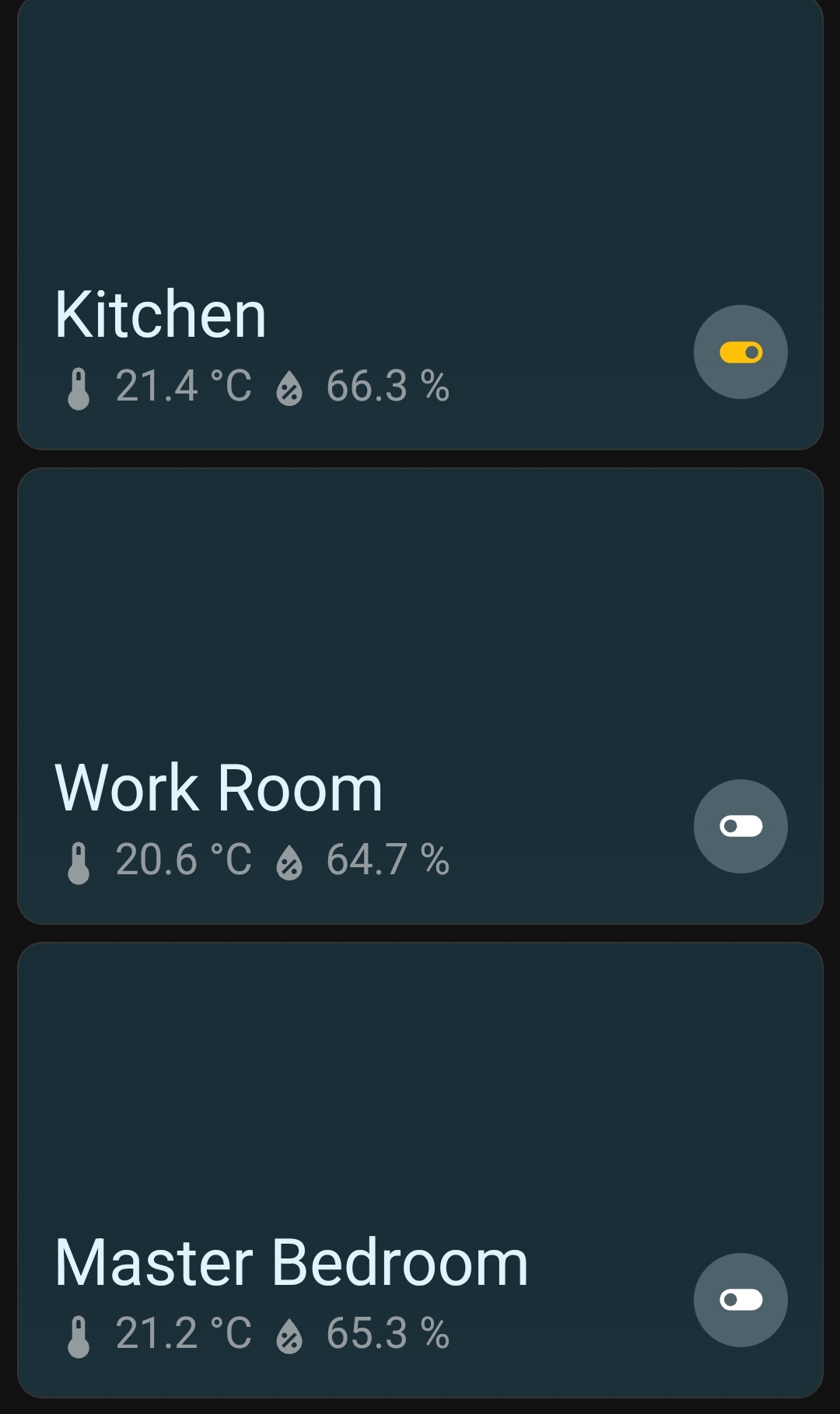We built a house 7 years ago and it’s insulated and has double glazing. I’ve installed Home Assistant with temp sensors in the bed rooms and seeing 70%+ humidity levels. Temperature is always above 16c
We ventilate it, but still it’s 70% in the bedrooms. WHO recommends 40-60%, so we’re a bit worried.
Living room is around 55% during the day when we have the heat pump set at 21c.
As it’s pretty humid outside I think it’s almost impossible to get it lower, but are there any other tips? I don’t want to run dehumidifiers. Would an HRV like system help?
So your house is insulated and warm, and presumably pretty sealed. I think you should be considering sources of water vapour.
Some common sources:
- Shower
- Drying clothes inside
- Cooking
If you have a separate shower (rather than shower over bath) you can get a shower dome which significantly reduces steam leaking outside the shower. I don’t much like using a shower with one but they are effective. You can also get a more powerful extractor fan, though even the super powerful ones don’t seem to be that powerful (I want one that sucks your clothes off).
If you dry clothes inside, try not to. If you have a dryer that isn’t a condenser dryer, try to vent it outside or at least open the window. Probably try to use it less though using it less and not drying clothes inside don’t make for many options in the winter.
For cooking, make sure you have a rangehood to catch the steam from any boiling pots. And make sure it’s externally vented. I have lived in placed with rangehoods that just push the air back into the room (I’m not sure of the point…) but I’d think with a house that new it wouldn’t be an issue.
You might have other ideas about sources of water. Gas heaters can be one but it sounds like you heat with a heat pump.
An HRV/DVS can help but I’m not sure it’s as effective in a newer house.
You also mention the living room is 55% in the day when heated to 21c, what temperature are the bedrooms when they are 70%? Colder air can hold less water, and so the relative humidity is higher with the same amount of water in the air.
Thanks Dave, much appreciated! Yes, I guess it’s from internal sources, like shower, drying clothes and cooking. Will try to decrease that, but as you said, drying clothes outside is not really an option in winter.
So, right now, living room is [email protected]%. Bed room 1 is [email protected], bed room 2 is [email protected]%, bed room 3 is [email protected]% We’ve got doors open so it should stabilize a bit more. I understand that higher temps means lower RH, but I don’t want to heat bed rooms to 21c. There are panel heaters in each bed room, which are set at 16c during the night, and at 19c at the end of afternoon until 6pm.
Garage is [email protected]; which is not insulated & not heated.
Think as a gap stop I’ll get a dehumidifier, especially for the colder winter months.
Other than the garage, those temperatures/humidities all have a similar amount of moisture in the air, the difference comes from the temperature of the room. See this calculator I googled up: https://www.omnicalculator.com/physics/absolute-humidity
So the warm air has X amount of water in it, and when it goes to the cold room it still has the same amount of water, but because cold air can hold less water the relative humidity goes up. So I don’t think there’s anything special about the bedrooms.
The dehumidifier is probably a good idea, but before you go and buy one, check if your heat pump has a “dry” setting.
Thanks Dave again for the insights!
Our heat pump has a dry setting, but it must be set 2c lower than ambient temperature. So it’s getting quite cold. I was hoping / assuming that a dehumidifier wouldn’t cool that much.
But perhaps worth giving it a try for an hour or so.
Ah interesting, I’ve never read the instructions just hit “Dry”!
Don’t forget to warm the room back up before checking the humidity or the cooler air might make you think it hasn’t made a difference :).
On another note, I’ve always wanted to try home assistant but never got around to actually getting any equipment. What sensors did you get?
Don’t forget to warm the room back up before checking the humidity or the cooler air might make you think it hasn’t made a difference :).
Yes good point! Doing a test now, set to dry, will check how it goes.
On another note, I’ve always wanted to try home assistant but never got around to actually getting any equipment. What sensors did you get?
First of all, it can be a rabbit hole. Secondly, it’s awesome. I’ve set it up on a Raspberry Pi, and set up a Zigbee mesh with the Home Assistant SkyConnect dongle from here. I bought some Sonoff temp sensors, and Sonoff Smart Sockets to increase the Zigbee network range. I’ve also bought some Smart Sonoff Bulbs at Aliexpress but I’m not very happy with them as they caused some Zigbee network issues. Seems to have resolved it by itself somehow.
Our heat pump is not a smart one, so I’m using a Broadlink RM3 Mini to control my heat pump. Works like a charm. That way I would also be able to set it to dry and heat on intervals of e.g. 1 hour during the night.
Any other questions just ask.
Oh boy, that’s cheaper than I was expecting startup costs to be… I am oh so tempted now!
With HomeAssistant, as I understand it, it needs the full Pi? I have a bunch of services running on my RPi 4 and so when I’ve looked at HomeAssistant I haven’t been able to install this without touching the other stuff on there. I think they have a docker container version but it has a lot less features.
I have for a while been intending to uprade my stuff to something that can handle photos/videos better, but haven’t got around to it. I might need to wait until I do that, then I’ll have a spare Pi to use for HA.
I’m guessing an RPi 1B won’t handle it. It’s running Pi hole at the moment, but I think this is about the only thing it’s capable of.
Do you have any old x86 computers lying around?. I am running a NAS serving a dozen docker containers and a VM on an ancient 4th gen intel cpu. I never got into the home assistant stuff but maybe I’ll also give it a go! I use PhotoView to share photos with family through CloudFlare zero trust tunnel.
I have for a while been intending to uprade my stuff to something that can handle photos/videos better, but haven’t got around to it. I might need to wait until I do that, then I’ll have a spare Pi to use for HA.
I’m guessing an RPi 1B won’t handle it. It’s running Pi hole at the moment, but I think this is about the only thing it’s capable of.
Not sure, HA itself is not very demanding. Most demanding thing I’m running are NZB’s (extracting / par check), Photoview (to index the photos on my NAS), and Frigate (web cams with motion detection). I’ve set CPU limits for each docker container to ensure it’s not overloaded, installed a fan, and now it seems to perform okay.
With HomeAssistant, as I understand it, it needs the full Pi? I have a bunch of services running on my RPi 4 and so when I’ve looked at HomeAssistant I haven’t been able to install this without touching the other stuff on there. I think they have a docker container version but it has a lot less features.
I’m running it dockerized as well as I’m using it for other stuff as well, like PiHole, media server, etc. No problems at all.
Some features are missing, like editing config files in the browser. Major gap is that add-ons are not supported. Add-ons are essentially 3rd party apps, like DuckDNS, Frigate or MQTT. It’s mostly annoying because the documentation assumes you run the HASS version. But it’s no big deal, you can set up those apps yourself. I’m running Frigate and MQTT dockerized and connected to HA without issues.
For docker resources, check out https://www.linuxserver.io/. I used to install apps like NZBGet, Radarr, etc. all directly, which was very annoying as each app uses a different install script. With the docker compose files from linuxserver it was a breeze. I only run PiHole directly, as I saw some issues with the Docker version, the rest is all dockerized.
I’m seeing some odd behaviour. I’ve set the heat pump to dry twice, for about 30 minutes. Both temp and RH drop, which is good. However, as soon as I turn it back to heat, the RH jumps up about 6% within 5-10 minutes. The sensor is a couple of meters away from the heat pump, so that’s odd.
Also outside it’s 14.5c @ 72% so I have no idea how to get it 16c and below 60%. That seems only possible if I shut all windows and have dehumidifiers running 24/7. I see articles where they recommend 30-50% in winter, how the heck is that possible when it’s damp outside.
I’m seeing some odd behaviour. I’ve set the heat pump to dry twice, for about 30 minutes. Both temp and RH drop, which is good. However, as soon as I turn it back to heat, the RH jumps up about 6% within 5-10 minutes. The sensor is a couple of meters away from the heat pump, so that’s odd.
Could this be as simple as the heat pump is blowing out dry air, but hasn’t turned over much air total. Then when you stop it, the dry air mixes with other air around the house and the humidity comes back up?
Also outside it’s 14.5c @ 72% so I have no idea how to get it 16c and below 60%. That seems only possible if I shut all windows and have dehumidifiers running 24/7. I see articles where they recommend 30-50% in winter, how the heck is that possible when it’s damp outside.
I dunno man. I tend to think I live in a warm, dry house. We only heat rooms we are using but otherwise we don’t hesitate to turn on a heat pump. We have never had an issue with mould or dampness. But I just have this feeling when I get some sensors they are gonna say 70% like yours and I’m gonna have to go down a rabbit hole trying to work out why!
We do have a DVS, but ours is an older home. I think they help more with heat recovery (all they do is pump air from your ceiling cavity into your house - which is often warmer because heat rises). They do slightly pressurise the house because they are pumping air in, which can help stop outside air getting in cracks, but I can’t imagine a fairly new house like yours would have the same issue with that as our 50’s house. Maybe throw a sensor in the ceiling and see if the air is warm and dry up there?
I think your assessment is likely correct, 30 minutes isn’t long for a dehumidifier to do much work, and unless there’s a unit in each room, or its central then for the total volume of air it won’t have pulled much more than was in the general area its located.
Yeah we assumed our house wouldn’t have moisture issues being so new. But… If I hadn’t measured I wouldn’t know as we don’t have massive moisture issues. Main issue is condensation on the window frames as they are not thermally broken. Well it is what it is.
I’ve ordered a 10L dehumidifier, we’ll ventilate more, and let’s see how it goes then.
It’s not so easy to get onto the ceiling but it’s indeed worthwhile.
Ah interesting, I’ve never read the instructions just hit “Dry”!
Yeah, I noticed it didn’t do anything when set to e.g. 22c when it was already 22c there. Then I read the manual, which is a bit cryptical:
When the room temperature is higher than the temperature setting: The device will dehumidify the room, reducing the room temperature to the preset level. When the room temperature is lower than the temperature setting: Dehumidifying will be performed at the temperature setting slightly lower than the current room temperature, regardless of the temperature setting. The function will stop (the indoor unit will stop emitting air) as soon as the room temperature becomes lower than the setting temperature.
Notice the bold part. First it says, if the temp setting is higher/same as ambient, it will perform slightly below ambient. However, next sentence it says it stops when temp setting is higher/same as ambient?
I have to set it e.g. 2c lower than ambient, otherwise it just doesn’t do anything
Yes I noticed it contradicted itself. I think that was probably referring to the earlier part, that you start it when the temperature is high then it keeps going until it reaches the set temperature.
I am going to go and play with ours now, we haven’t really used that setting, but I have no idea what the humidity is in the house. I’ve just in the past in a different house had to work out how to reduce dampness and mould.
Yes I noticed it contradicted itself. I think that was probably referring to the earlier part, that you start it when the temperature is high then it keeps going until it reaches the set temperature.
Yes, guess you’re right.
I’ve got a cheap weather station from Aliexpress which also has a humidity sensor, that could be a temporary solution for you if you don’t go for the HA route.
A dehumidifier will actually add a bit of heat.
Dry setting while you’re out of the house during the day?
Tried dry during the night, didn’t do anything for humidity.
So many folks overlook the Dry setting on a heatpump :)
Though as I learnt from this thread, it’s so much more complicated than just turning it on!
You could probably solve most of this problem by installing an ERV but those are fairly expensive.
What do you mean exactly you ventilating. Mechanical ventilation?
Modern houses NEED mechanical ventilation. It’s a travesty that new houses in NZ don’t come with mechanical ventilation as standard, as is done in the rest of the developed world.
It’s pretty obvious if you think about it. Seal the house well, well insulated, double glazed. How will the moisture leave without ventilation. This is why modern houses NEED mechanical ventilation. Older houses don’t need mechanical ventilation because the house is already leaky.
And not the silly DVS thing. I don’t want rat infested air from my attic thank you. I don’t care how good the filters are. Ventilation from the outside please.
What this looks like is intake vents in the soffit, a duct, and fan that pumps fresh air in for positive ventilation. Our you can do negative pressure where it pumps out, or balanced where you have air coming both in and out. You can install a mechanical heat recovery system if the house gets cold.
Full HVAC includes ducted heating/cooling.
TLDR: your house is humid because it’s well sealed and the builders couldn’t be bothered putting in mechanical ventilation because we are 20 years behind the rest of the world.
If you already have mechanical ventilation then it is likely not installed properly. Just putting it in doesn’t necessarily mean it’s sized correctly for example.
What do you mean exactly you ventilating. Mechanical ventilation?
We’ve got mechanical ventilation in the bathrooms.
But I meant just old school opening all the windows :)
TLDR: your house is humid because it’s well sealed and the builders couldn’t be bothered putting in mechanical ventilation because we are 20 years behind the rest of the world.
Yes, I understand that, we generate moist from cooking/breathing/washing and that has to go somewhere. We’ve got many windows open a little bit 24/7.
I’m from Europe, and yes, houses are better insulated, we had double glazing 30 years ago, and now have triple glazing, but ventilation was never an issue. We just open our windows to ventilate for e.g. an hour and that’s it.
You would probably have had air bricks too.
4 year old house, double glazing. We have the heat pump set at 21dg on 24x7 all winter and never really open windows.
Current temps and moisture levels:

If you’re worried about moisture I recommend a dehumidifier, those things work wonders and much cheaper than retrofitting ventilation like the other poster mentioned.
I guess it’s worth mentioning, we have a tumble drier in the garage so the house doesn’t get any moisture from drying clothes.
A lot of modern heat-pumps have a dehumidifier mode. But likely if they’re set to Auto they’ll never switch to using it I think.
Thanks. Those numbers are similar to ours. We never really opened windows either, we’re aiming to do that daily from now on.
Just bought a dehumidifier. Indeed easiest and cheapest solution.
I’m ok with that humidity to be honest, I am not seeing any mould.
We only a little bit in certain clothes and in the bottom of our alu window frames.
Still above 60% is apparently not healthy. I’d recommend to look into it.
Thanks for further details. I would definitely invest in getting HVAC installed in that instance or if cost is an issue then at minimum install simple positive pressure mechanical ventilation from the outside into the bedrooms. This should fix your problem. It sounds like windows aren’t enough because the house is well sealed, so you need a mechanical solution. Please don’t get DVS from the attic.
I live in a new house with HVAC and leave the mechanical ventilation on when not heating or cooling and it keeps moisture levels low. I also got HVAC retrofitted into my previous house which made a massive difference in moisture. I’ll never live in a house without HVAC in the future if I can help it.
We do have HVAC, in a heat pump. It’s running all day. A complete system like HRV is a bit too much for now. The dry setting is annoying as it is cooling. Not handy mid winter.
You mean a split system? A heat pump usually refers to a split system which doesn’t have the V in HVAC as it just recirculates air. HRV is the ventilation from the attic thing, please don’t get that.
HVAC generally refers to ducted aircon with mechanical ventilation. The “heat pump” sits in the attic. Fresh air is taken in from the outside through the soffit. Ducts run from the “heat pump” into each room.
If a ducted system is too expensive then you should install plain mechanical positive pressure ventilation from the outside (not HRV/DVS) Depending on your house it is possible to DIY this using stuff from Bunnings. You could even link the fan to your Home Assistant and get it to activate when the humidity reaches a certain threshold. This should fix your problem. If it causes the house to get cold by doing this then you could install a mechanical heat recovery device.
Thanks mate, that is very useful. Yes, we indeed only have a heat pump.
I looked into HRV/DVS alternatives some time ago, and Cleanaire was recommended on e.g. Geekzone; which gets the air from outside & heats it. Quote was $4-5k which is a bit steep as we’re not sure how long we’ll be living here.
A DIY option for a PIV isn’t too bad. I could leave it running overnight and use the heat pump to keep the house above 16c.
I also bought a small dehumidifier as a stop gap.
I’ve left the heat pump running on dry / heat cycles overnight (1 hour dry to 17c, 1 hour heat to 19c). Didn’t do anything, RH at the end was exactly the same as the night before.
Oh wow mechanical heat recovery systems have jumped in price. They were 2-3k a few years ago. The way mechanical heat recovery works is kind of like penguin legs. The inflow and exhaust airflows pass by each other. So the warm exhaust air passively heats the cooler inflow air. So they are quite basic things that are very cheap to run. I guess another kiwi tax. Done some googling for pricing and it does appear 5-6k is the going rate now. E.g. another option: https://www.smooth-air.co.nz/home/hex390
What about something like this: https://www.smartvent.co.nz/why-smartvent/ that should also improve the humidity. Doesn’t say price though. They seem to have a variety of options including positive pressure which should be much cheaper than a heat recovery system. https://www.smartvent.co.nz/smartvent-positive-advance/
Here’s some more information about heat recovery systems and why DVS/HRV from the attic are shit. https://www.smarterhomes.org.nz/smart-guides/heating-cooling-and-insulation/ventilation-and-heat-recovery-systems/
Thanks for the details!
Smooth air has kits for just ventilation for 1.5k for 2 rooms. Smartvent is more expensive, like 4k, they have some pricing.
I don’t need a lot of bells and whistles. I can automate it myself. Just an outdoor outlet and an indoor outlet, ventilator and two pipes for just the living room.
I read your article, they say HRV/DVS is bad for heating, but not if you use it just for ventilation?
One other easier option is to just have a simple diy DVS by using the air from the attic. I’m going to check the moisture levels there first.
Sorry to bother you again, but wouldn’t something like this work? Instead of connecting to the heated room as inlet, I’d connect it to the outside. Of course has to be water proofish.
https://www.mitre10.co.nz/shop/weiss-heat-transfer-kit-1-room/p/175013
70% you need to be running dehumidifiers…
It’s not just mold that’s an issue, it can cause structural damage.
As I understand it, dehumidifiers are not a proper long term solution for an entire house; they are recommended for rooms where ventilation is hard.
You can call an HVAC specialist and get something more permanent, but you need to do something ASAP.
But you can absolutely get one with a drainage tube and run it 24/7 tho. Lots of people in older houses in America do it.
Thanks. You mean a dehumidifier with a drain tube? I haven’t seen one here in NZ.
Makita sell a handy tool that can fix that 🤣
I can’t speak to NZ, but even a normal tank dehumidifier should have the option for a drain line. It’ll usually be a hose fitting hidden above/behind where the tank sits, so you can run a line to whatever household drain is nearby. And if it doesn’t already have a fitting, it’s usually pretty simple to add one.
It can make placement a hassle since you need to be near a drain, but you’ll barely need to touch it beyond setup. It’s a huge upgrade from dumping the tank constantly.
Yes, just bought one, and it has a drain outlet. Never knew that. Thanks!
Vapour barrier. Vapour barrier. And maybe a vapour barrier.
They’re really cheap and only a little difficult to install. I’ve installed them in every house I’ve ever lived in. In our current house things dried out so much some of our floorboards warped a little. They are magic.
Never heard of that, thanks. Our house is built on a concrete slab, so don’t think that will work?
If there’s an air-gap between the slab and your floor, and you can get in there, then yeah it will help. Concrete is remarkably porous to water.
Sounds like a reasonably new build. If it’s slab on grade they would have put down a vapour barrier prior to pouring the concrete slab.
Hvac is oversized and not running long enough. Super common issue especially when people tighten up their house
What sensors are you using to measure your humidity? Have you got anything you can calibrate against?
I’ve got Sonoff SNZB-02 temp sensors. I also have a weather station; there is a difference of up to 5%, so I am taking the readings with a grain of salt.
I just bought a dehumidifier which has a RH sensor as well, which is almost the same as the reading of my Sonoff sensors.






